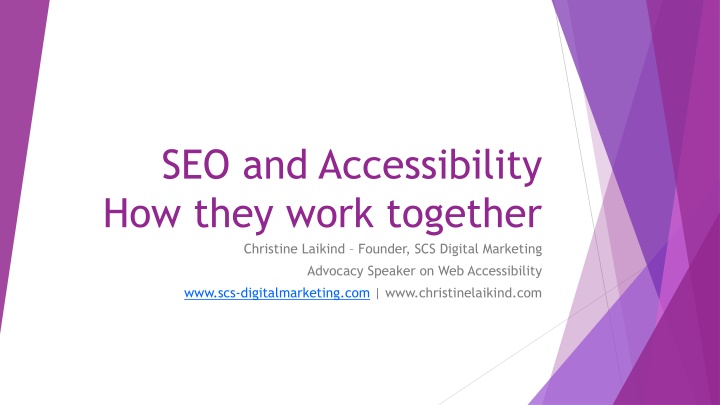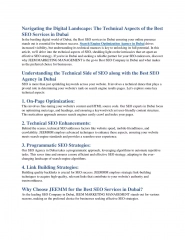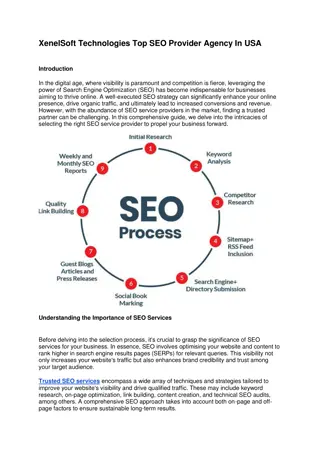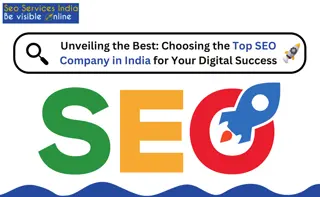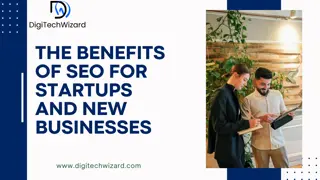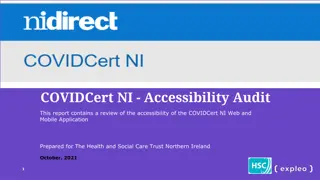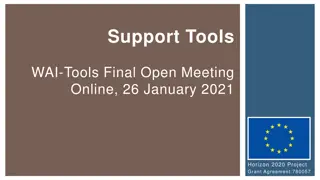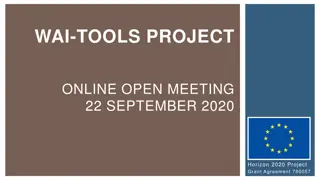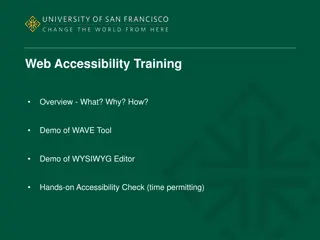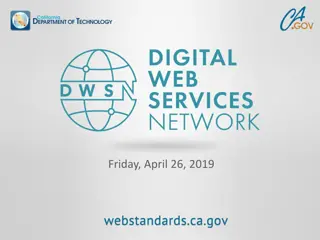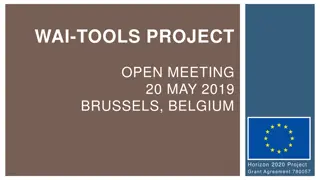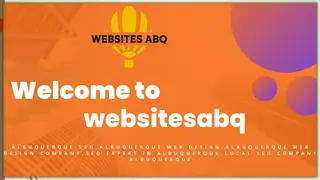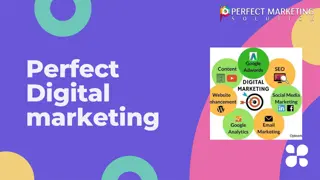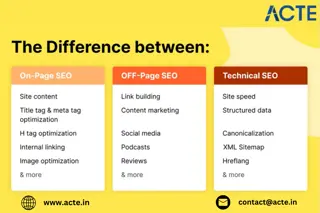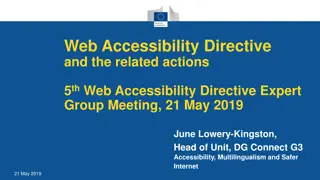The Relationship Between SEO and Web Accessibility
Web accessibility ensures equal access for all, including people with disabilities. It is not just a legal obligation but also a moral imperative, leading to increased rankings, new demographics, and additional revenue for optimized websites. Embracing differences and prioritizing inclusivity is key for success in the digital landscape.
Download Presentation

Please find below an Image/Link to download the presentation.
The content on the website is provided AS IS for your information and personal use only. It may not be sold, licensed, or shared on other websites without obtaining consent from the author.If you encounter any issues during the download, it is possible that the publisher has removed the file from their server.
You are allowed to download the files provided on this website for personal or commercial use, subject to the condition that they are used lawfully. All files are the property of their respective owners.
The content on the website is provided AS IS for your information and personal use only. It may not be sold, licensed, or shared on other websites without obtaining consent from the author.
E N D
Presentation Transcript
SEO and Accessibility How they work together Christine Laikind Founder, SCS Digital Marketing Advocacy Speaker on Web Accessibility www.scs-digitalmarketing.com | www.christinelaikind.com
What does it mean Web Accessibility In short: it is making the website inclusive and accessible to everyone including to those who have disabilities. Who said we want to conform to the norm? Celebrate & embrace our differences. ~ Neil Milliken
25% of adults* in the US have some sort of disability demographic that you are ignoring and leaving money or opportunities behind. ADA lawsuits on the rise. Small businesses are affected. It is not just large companies that are getting sued. Why It is Important *301 million people are adults in USA. Estimated 52 million adults have some sort of disability. Who said we want to conform to the norm? Celebrate & embrace our differences. ~ Neil Milliken
It is the right thing to do. Web Accessibility means equal access for everyone including those who have disability. Inclusion Who said we want to conform to the norm? Celebrate & embrace our differences. ~ Neil Milliken
It cost too much (to do the stuff to make web accessible) Address the myths There s really no benefit or ROI (to make web accessible) It will interfere with functionality and design (of my website to make it web accessible) Who said we want to conform to the norm? Celebrate & embrace our differences. ~ Neil Milliken
Reality There is really no extra cost it needs to become part of the design process, not an after thought. There is a benefit and ROI= increased rankings, new demographics, additional revenue from an optimized site. An optimized site is actually a well designed website with good user experience. Who said we want to conform to the norm? Celebrate & embrace our differences. ~ Neil Milliken
FACT: websites that take web accessibility seriously consistently rank higher than their competition on Google and YouTube. Why? Because Search engine optimization (SEO) best practices and following the Web Content Accessibility Guidelines (WCAG) actually overlap! Who said we want to conform to the norm? Celebrate & embrace our differences. ~ Neil Milliken
To understand Web Accessibility first, understand how the web is being used by those who have a disability: Assistive Devices Web Accessibility Keyboard Screen Readers Captioning or Transcripts And lastly how you design the website also has an effect on web accessibility. Who said we want to conform to the norm? Celebrate & embrace our differences. ~ Neil Milliken
Web Accessibility Web accessibility can help improve your SEO by keeping your website s interface cleaner, easier to navigate, and improving the bounce rate among other benefits. Who said we want to conform to the norm? Celebrate & embrace our differences. ~ Neil Milliken
Web Accessibility and Your Market Web Accessibility means that people with disabilities can use the web. How they experience it may be different, but they still have the right to access or experience the content you are delivering. Who said we want to conform to the norm? Celebrate & embrace our differences. ~ Neil Milliken
Three types of disabilities: Permanent: blind, deaf, and so on Every Day People Episodic: example of this would be epilepsy, mental illness, migraines, pstd Conditional or Situational: example can be slow internet connection or broken leg or arm, dyslexic, color blindness Who said we want to conform to the norm? Celebrate & embrace our differences. ~ Neil Milliken
CONTENT is KING in both accessibility and SEO. SEO and UX equals success, right? Web Accessibility and UX equals SEO and that equals Success. Who said we want to conform to the norm? Celebrate & embrace our differences. ~ Neil Milliken
Lets count the ways: SEO BEST PRACTICES and WEB ACCESSIBILITY that are in close alignment Mobile Friendly How Does Web Accessibility Improve SEO? Strong Site Architecture Using Proper Alternative Text for Images Easy to Use Navigation (clear and consistent) Providing Descriptive Link Text Ensuring Page Titles are descriptive yet succinct Providing transcripts and captions for video and audio Providing useful links to relevant and related resources Who said we want to conform to the norm? Celebrate & embrace our differences. ~ Neil Milliken
SEO Best Practices: Users Come First Quality of Content: make sure the content focuses on visitor needs, Don t worry too much about keywords here Long form (minimum of 500 words, 1900 words) If you use video, which is popular, make sure it is captioned and transcribed. (Closed Captions are text files that are searchable and increase engagement) Who said we want to conform to the norm? Celebrate & embrace our differences. ~ Neil Milliken
SEO Best Practices: Users come first Strong Site Architecture Means Flat Architecture Users and crawlers can reach any page on website in 4 clicks or less Make your hierarchy logical. Each main category should be unique and distinct Subcategory relate to the main category Keep the number of main category between two and seven Balance the subcategories within each category, keep it even Who said we want to conform to the norm? Celebrate & embrace our differences. ~ Neil Milliken
SEO Best Practices: Users Come First User Experience Easy Navigable Website: Relevant Internal Linking Related Content Use Proper Heading they create logical hierarchy, organize thoughts. Site Speed is Quick website download fairly quickly Calls to Action it should clearly state what the visitor should get when they click. While each page may have one primary goal, not every visitor will be ready to convert, provide a secondary goal to keep the visitor engaged. Who said we want to conform to the norm? Celebrate & embrace our differences. ~ Neil Milliken
SEO Best Practices: Users Come First User Experience Use Proper Heading they create logical hierarchy, organize thoughts. If possible, Use only one H1 per page, per good design and accessibility practices Other headers, such as h2-h6 should be used to organize the rest of your webpage so site visitors can easily scan content and understand each session is about. Screen Readers will be able to accurately portray the website if done this way H1 H2 H3 H1 H2 H2 Who said we want to conform to the norm? Celebrate & embrace our differences. ~ Neil Milliken
SEO Best Practices: Users Come First Relevant Internal Links Internal Links is one that points to another page on the same website. Use descriptive keywords in anchor text that gives a sense of topic or keywords the course page is trying to target. SEO best practice: it is useful for establishing site architecture and spreading link equity. Best Practices: Content Links- make sure it is relevant, not broken, one click away Call to Action Links keep it above the fold. Present on each page Who said we want to conform to the norm? Celebrate & embrace our differences. ~ Neil Milliken
SEO Best Practices: Users Come First Descriptive Link Click here is not descriptive link, neither is: Read more SEO Friendly is: Succinct Relevant to the linked to page Low Keyword density Not generic Best Practices: Subscribe to our newsletter Download the manual as PDF Contact Us for more information Who said we want to conform to the norm? Celebrate & embrace our differences. ~ Neil Milliken
Easy to Use Navigation Buttons and Links Size (screen and font size) SEO Best Practices: Mobile Friendly Cross Device Compatibility (smart phone, tablets, desktop) https://blog.hubspot.com/marketing/ mobile-website-design-examples Who said we want to conform to the norm? Celebrate & embrace our differences. ~ Neil Milliken
SEO Best Pratices: Mobile Friendly Shutterfly Evernote Zappos Who said we want to conform to the norm? Celebrate & embrace our differences. ~ Neil Milliken
Good on-page SEO practices SEO Best Practices: Alt- Tags Use Alt-tags for all of your images improves your accessibility and USER EXPERIENCE Alt tags on all image will also provide greater relevance to search engines It is a lazy and bad habit to be uploading images like: img001.jpg. Who said we want to conform to the norm? Celebrate & embrace our differences. ~ Neil Milliken
Why Its Important? SEO Best Practices: Alt- Tags Accessibility Alt text is a tenet of accessible web design. Its original (and still primary) purpose is to describe images to visitors who are unable to see them. This includes screen readers and browsers that block images, but it also includes users who are sight- impaired or otherwise unable to visually identify an image. Who said we want to conform to the norm? Celebrate & embrace our differences. ~ Neil Milliken
Why Its Important? SEO Best Practices: Alt- Tags Image SEO alt text offers you another opportunity to include your target keyword. With on-page keyword usage still pulling weight as a search engine ranking factor, it's in your best interest to create alt text that both describes the image and, if possible, includes a keyword or keyword phrase you're targeting Who said we want to conform to the norm? Celebrate & embrace our differences. ~ Neil Milliken
Describe the image as specifically as possible. Alt text is, first and foremost, designed to provide text explanations of images for users who are unable to see them. Keep it (relatively) short. The most popular screen readers cut off alt text at around 125 characters. Good Alt-tags: Keep Users In Mind Use your keywords. Alt text provides you another opportunity to include your target keyword on a page, and thus another opportunity to signal to search engines that your page is highly relevant to a particular search query. While your first priority should be describing and providing context to the image, if it makes sense to do so, include your keyword in the alt text of at least one image on the page. Who said we want to conform to the norm? Celebrate & embrace our differences. ~ Neil Milliken
Good Alt-tags Who said we want to conform to the norm? Celebrate & embrace our differences. ~ Neil Milliken
Who said we want to conform to the norm? Celebrate & embrace our differences. ~ Neil Milliken
Closed Captions and Transcripts Provide them for your videos and podcasts Video and Audio Files Text transcript will make it easier for Google and other search engines to index the content It will help your Google ranking Not only benefits the deaf, think about temporary or situational disability Who said we want to conform to the norm? Celebrate & embrace our differences. ~ Neil Milliken
SEO Best Practices How Transcripts Help Boost SEO Google Crawlers can t hear audio. Transcripts TELL them what your podcast is about so they (crawlers) can index and rank accordingly. Examples: https://www.thisamericanlife.org/317/transcript https://storycorps.org/stories/amy-sherald-and-elise-pepple/ http://freakonomics.com/podcast/creativity-5/ Who said we want to conform to the norm? Celebrate & embrace our differences. ~ Neil Milliken
Digital Marketing Agency for Speakers, Coaches and Trainers Quick Intro Christine Laikind Advocacy Speaker on Web Accessibility Born deaf due to genetic defect Do know ASL, but don t use it I depend on lip reading to understand others and use various technology to conduct business or do what everyone else does. Who said we want to conform to the norm? Celebrate & embrace our differences. ~ Neil Milliken
Copy of this presentation https://www.scs- digitalmarketing.com/events/ Download SEO Best Practices Checklist (PDF) on the website Who said we want to conform to the norm? Celebrate & embrace our differences. ~ Neil Milliken
